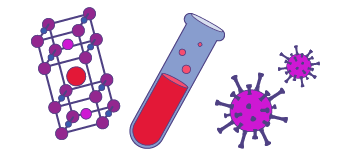This includes High-field Contrast Mechanisms and Agents, Lithium Battery MRI, and Materials MRI.
With the commissioning of stronger magnets for MRI at the MagLab, challenges arise with existing contrast agents such as iron oxides and gadolinium-based (Gd) agents. Many new opportunities for novel agents emerge, such as dysprosium-based (Dy) agents that can enhance sensitivity at these field strengths. Today, the most common contrast agents are iron oxide-based agents, which provide a hypointense signal due to their susceptibility-induced gradients, causing a dephasing of proximal spins. Although the iron particles are saturated at fields up to 1 tesla, the increased susceptibility artifacts can still provide increased contrast, especially with T2* weighted sequences.
At the MagLab, we use a variety of iron-based agents. Most common are the commercial super paramagnetic iron oxides (SPIO) that are either micron-sized (MPIO) or nanometer-sized (USPIO). These agents are used for a variety of applications. We currently use them for cell labeling and in in vivo tracking of endogenously or exogenously labeled stem cells. We also collaborate with Florida State University’s Chemistry Department and other institutions to modify these SPIOs for multimodality properties and to develop novel contrast agents such as Dy-conjugated quantum dots. Dy, in contrast to the commonly used Gd agents, show increased relaxivity with higher field strengths. Recently, we have also investigated Dy and Gd conjugated ultra-short carbon nanotubes (DNT and GNT, respectively) in collaboration with Rice University.
We are always interested in working with collaborators to investigate high-field MRI contrast agents. We can either provide contrast agents for your research needs, such as cell tracking, or collaborate to develop novel, high-field agents. The 21.1 tesla magnet, with its commercial and homebuilt coils, can accommodate a wide verity of samples, ranging from in vitro solutions and cell samples to animal models. In addition, we have access to other lower-field magnets that can be used for these purposes.
The following instruments at AMRIS facility are available for this technique:
The following instruments at NMR facility are available for this technique:
This following probes can be used with this technique:
For more information, please contact Sam Grant in Tallahassee or Glenn Walter at AMRIS in Gainesville.
The following instruments at NMR facility are available for this technique:
This following probes can be used with this technique:
For information, please contact Sam Grant in Tallahassee.
This following instruments can be used with this technique:
This following probes can be used with this technique:
For more information, please contact Sam Grant in Tallahassee.

Explore our magnet schedule to see what exciting research is happening on our stellar fleet of instruments right now.
Last modified on 11 December 2023